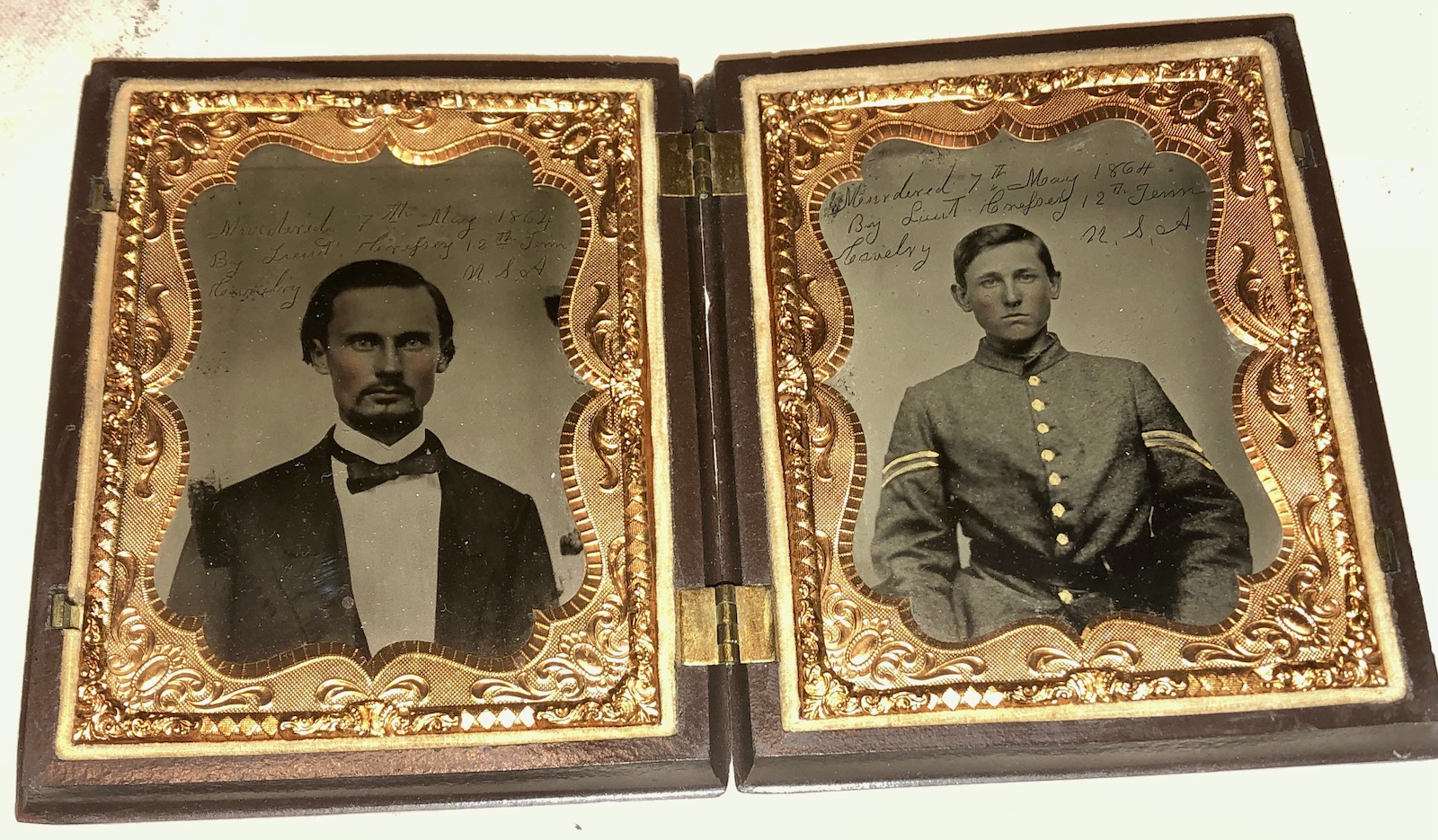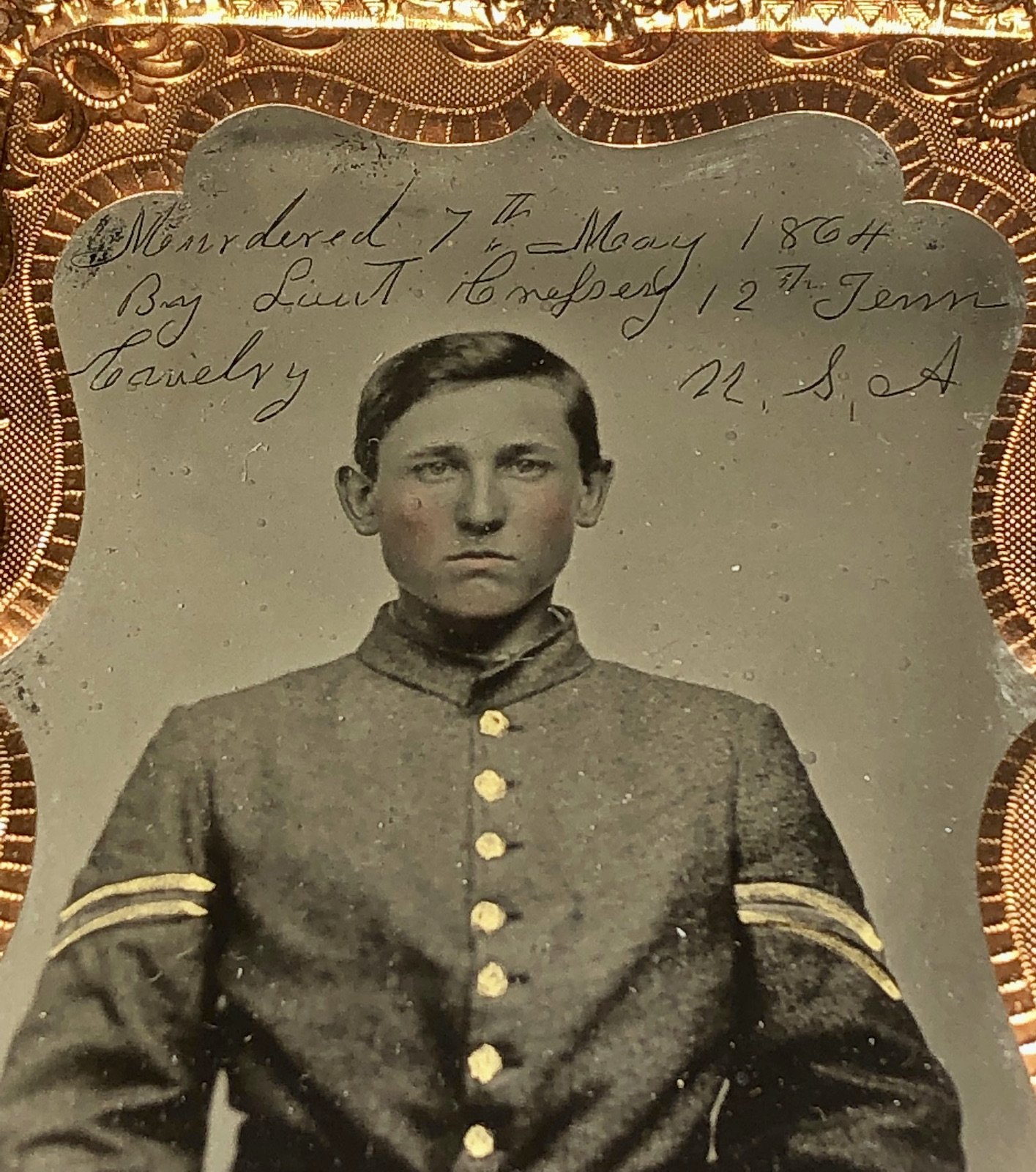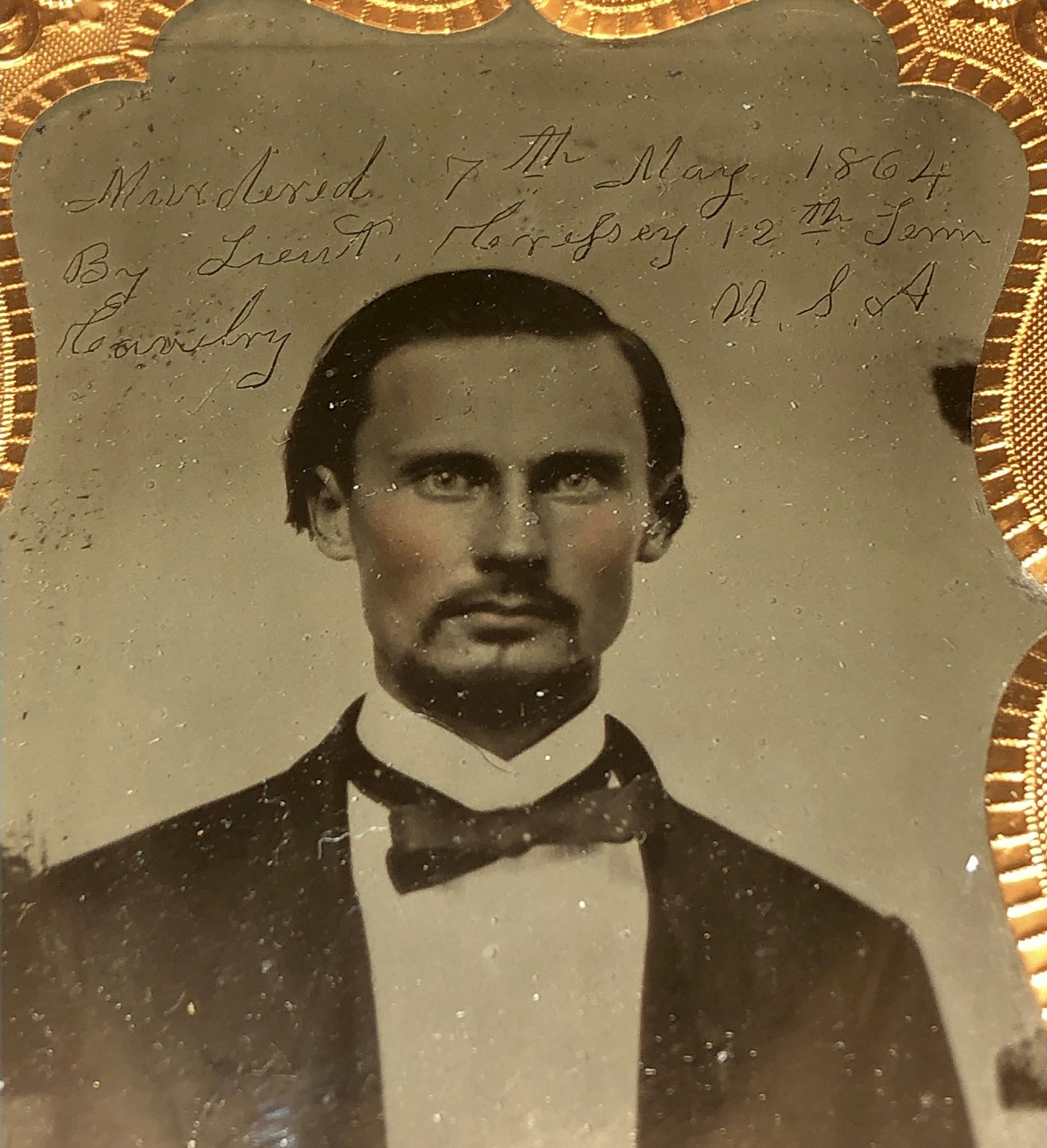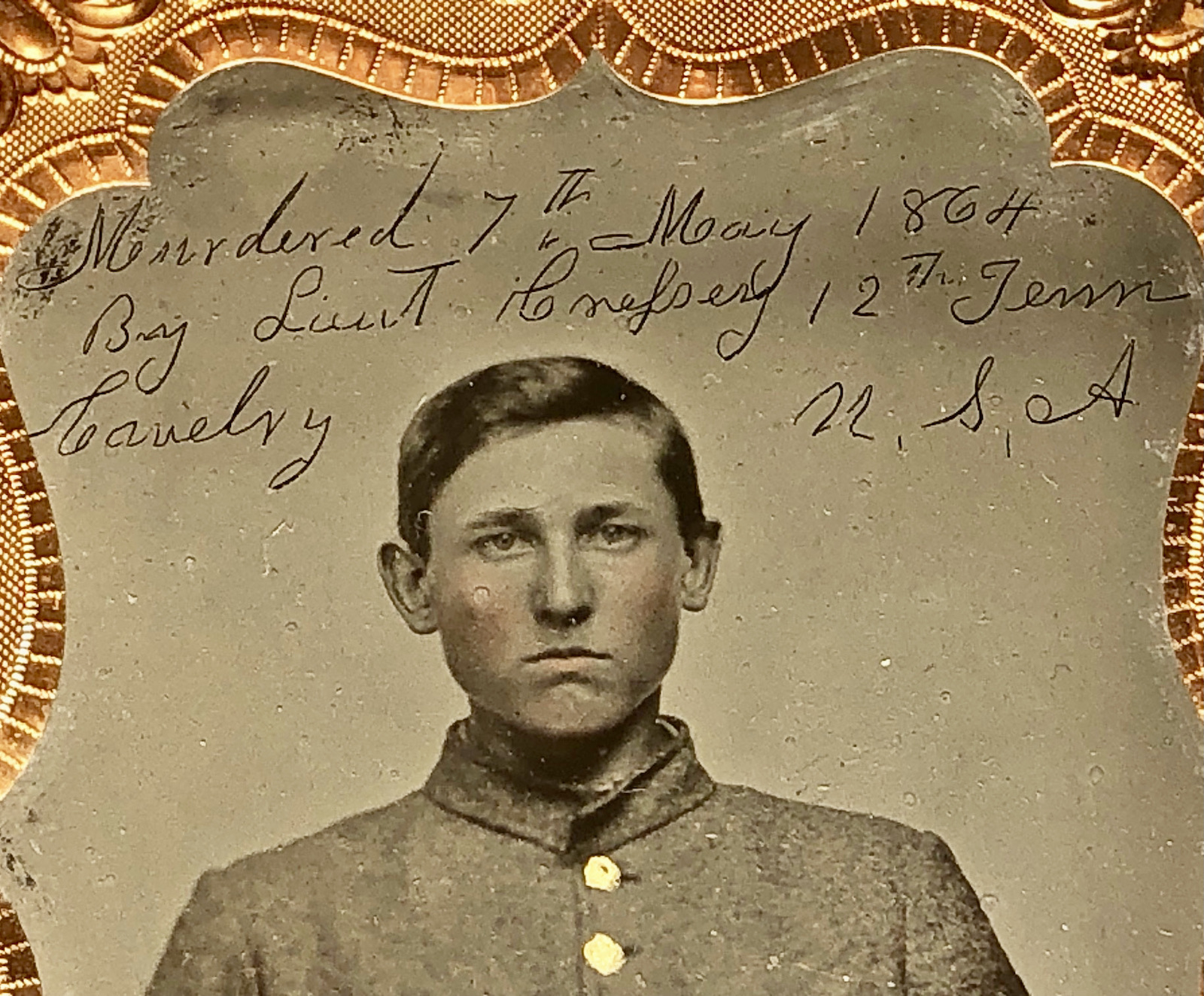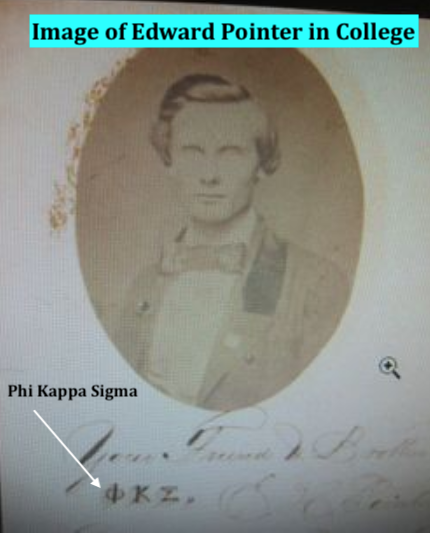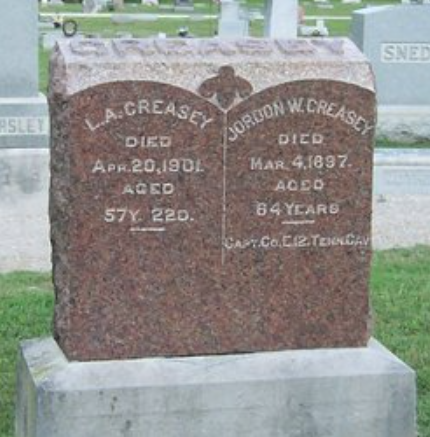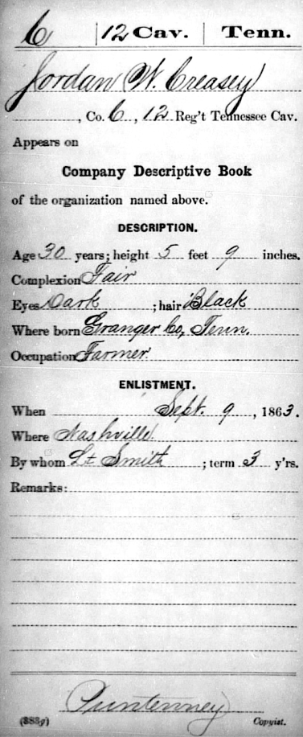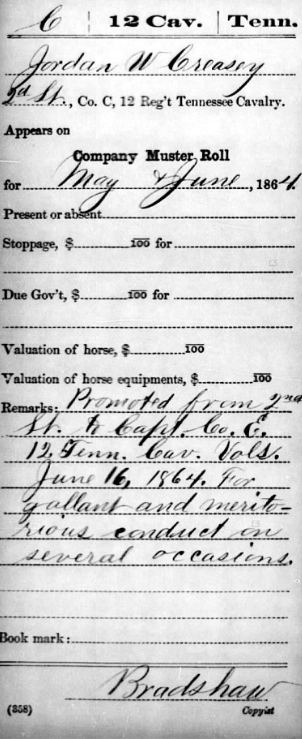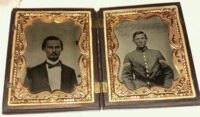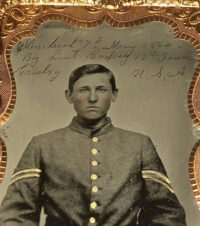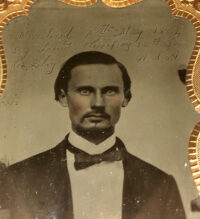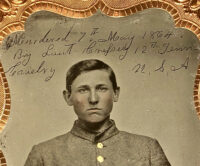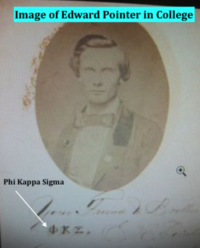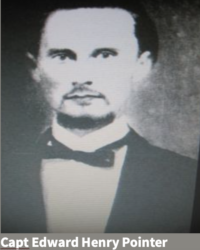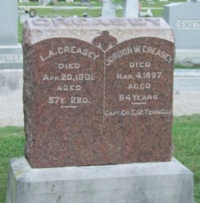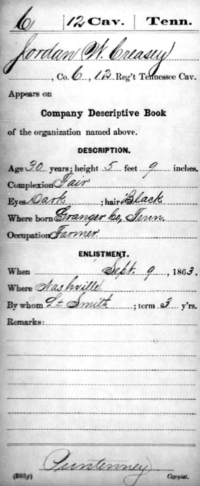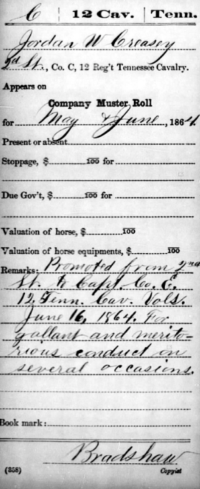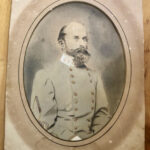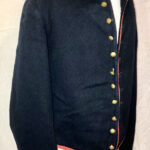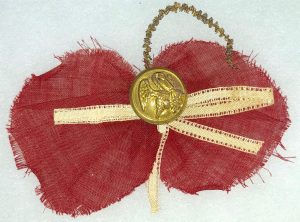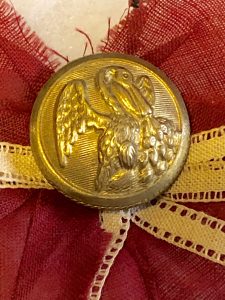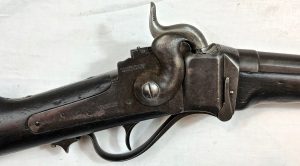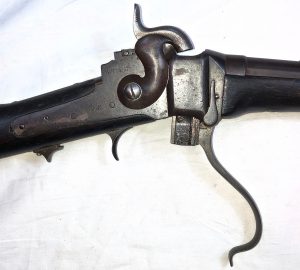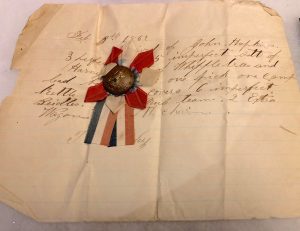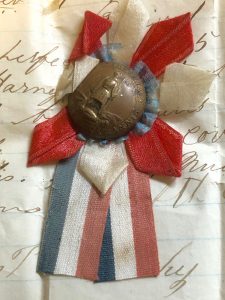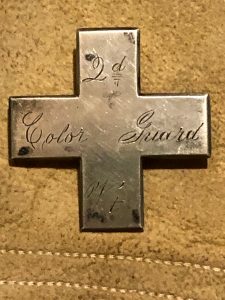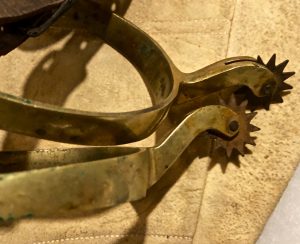Tintypes of Two Confederate Tennessee Cavalrymen Killed by Lt. Jordan W. Creasey, 12th Tennessee Cavalry (Union) – ID Scratched in the Emulsion of Both Plates
SOLD
Tintypes of Two Confederate Tennessee Cavalrymen Killed by Lt. Jordan W. Creasey, 12th Tennessee Cavalry (Union) – ID Scratched in the Emulsion of Both Plates – These two, sixth plate images are housed in a single, fine thermoplastic case. The images depict two Confederate, Tennessee, Cavalry soldiers – Edward H. Pointer and Spencer W. Buford, both enlisted men in Co. G 11th Tennessee (Holcomb’s) Cavalry; Pointer is in civilian garb, while Buford is wearing a depot shell jacket, with corporal stripes. Significantly, scratched into the emulsion above the image of each solider is the following:
“Murdered 7th May 1864
By Lieut Cresey 12th Tenn
Cavelry U.S.A.”
The description of how these two Confederate cavalrymen were killed, on May 7, 1864, depends upon which account of their demise you consult – the Confederate account, enumerated in the “Military Annals of Tennessee (Confederate)” or the “Official Records of the War of the Rebellion” published after the war by the U.S. Federal Government. According to the Confederate version, as stated by Lt. Colonel Daniel Wilson Holman, commander of the 12th Tennessee Cavalry or Holman’s Partisan Rangers, the incident transpired as follows:
“Private Edward H. Pointer, a young man of intelligence and promise, was murdered by the Federal troops after had surrendered. They took his own pistol and shot him. Pointer was on detached service as a scout and was captured at or near the house of Mr. Bradford, on Lick Creek, in Hickman County, Tennessee, on the 7th of May, 1864. The company who murdered him is said to have been commanded at the time by one Capt. or Lt. Creecy.”
Corporal Spencer W. Buford was transferred (per his own request) into the 9th Tennessee infantry, because his relatives, from Obion County, were serving in the 9th Tennessee Infantry. According to the compiled service records of Buford while serving in the 9th Tennessee Infantry, he was admitted to Way Hospital, on January 9, 1864, in Meridan, Mississippi. Once released from the hospital, it appears that Buford went home, in Williamson County, Tennessee and, in all likelihood, joined Holman’s Partisan Rangers, an active guerilla command, operating in that portion of Tennessee, in early 1864; this command is known to have conducted some spying on Union troop movements, as well as robbing Confederate stragglers and local civilians. Pointer and Buford were old friends from Williamson County and had served together, so it may have been that Pointer was meeting Buford to obtain military information.
According to the Official Records of the War of the Rebellion, a very much less militarily significant rendezvous occurred between Corporal Buford and Private Pointer; as recorded by Lt. Jordan W. Creasy of the 12th Tennessee Cavalry (Union), he had been made aware of the presence of two, Confederate guerrillas in the area, in early May of 1864. Per the account in the ORs:
“Lieutenant Creasy heard of two guerrillas, and after striking
their trail, he pursued them o’er hill and dale, until finally he was
upon them, they being concealed in a house of ill-fame, situated in a most
secluded spot on the top of a large bluff. The Lieutenant, fearing escape
on their part, dashed upon them alone and shot them both before any
of his party were on the spot. Much credit is due Lieutenant Creasy
for his gallantry in this single contest. The names of the killed are
Colonel Pointer and Lieutenant Buford. Four army pistols and three
Horses were found with them.”
Captain Russ B. Davis
10th Tennessee Volunteer Cavalry.”
Between the two images, that of Edward Henry Pointer, is on the left; his civilian attire indicates this to be a pre-war image. of him. Corporal Spencer W. Buford, seen in the right image, is wearing a Confederate depot, shell jacket with corporal chevrons on each arm. The images, as mentioned, are housed in a thermoplastic or Union case which remains in overall good condition, with some minor chips at one corner.
Edward H. Pointer
| Residence was not listed;
Enlisted on 9/22/1862 at Thompson’s Station, TN as a Private. On 9/22/1862 he mustered into “B” Co. TN Holman’s Part. Cavalry He was transferred out on 2/25/1863 On 2/25/1863 he transferred into “G” Co. TN 11th Cavalry He was Killed POW on 5/7/1864 at Lick Creek, TN He was listed as: * POW 5/7/1864 Lick Creek, TN
|
| BIRTH | 19 Jul 1841
Thompsons Station, Williamson County, Tennessee, USA |
| DEATH | 7 May 1864 (aged 22)
Hickman County, Tennessee, USA |
| BURIAL | Pointer Cemetery
Williamson County, Tennessee, USA |
Capt. Edward H. Pointer dates of birth and death came from his gravestone transcription, published in “Directory Williamson County, Tennessee Burials, Volume 1”, (Williamson County Historical Society: 1973), p. 248. He “fell in the Confederate cause”.
Edward H. Pointer, Enlisted on 22 SEP 1862 at Thompson’s Station, TN, as a private. He mustered into “B” Co., TN Calvary (Holman’s Part), He was transferred into “G” Co., TN 11th Cavalry, on 25 FEB 1863. From “Military Annals of Tennessee: Confederate”, edited by John Berrien Lindsley: Pointer was on detached service as a scout, when he was captured and killed, by Creecy’s company, on 7 MAY 1864, after surrendering at the home of Mr. Bradford, on Lick Creek, in Hickman County TN. Capt. Edward H. Pointer was the son of William H. and Sarah Louise Buford Pointer.
Spencer W. Buford
| Residence was not listed;
Enlisted on 10/13/1862 as a Corporal. On 10/13/1862 he mustered into “B” Co. TN Holman’s Part. Cavalry (date and method of discharge not given) (Estimated date of enlistment) |
Holman’s TN Cavalry Battalion
| Organized: on 10/13/62 Mustered Out: 2/25/63 |
| From | To | Brigade | Division | Corps | Army | Comment |
| Dec ’62 | Dec ’62 | Wheeler’s Cavalry | 2nd | Army of Tennessee | ||
| Dec ’62 | Feb ’63 | Wheeler’s | Wheeler’s Cavalry | Army of Tennessee |
11th TN Cavalry
| Organized: Columbia, TN on 2/25/63 Mustered Out: 2/13/65 |
| From | To | Brigade | Division | Corps | Army | Comment |
| Feb ’63 | Mar ’63 | Forrest’s Cavalry | Van Dorn’s Cavalry | Army of Tennessee | ||
| Mar ’63 | May ’63 | Starnes’ | Forrest’s | Van Dorn’s Cavalry | Army of Tennessee | |
| Jun ’63 | Aug ’63 | Starnes’/Cox’s/Dibrell’s | Forrest’s | Army of Tennessee | ||
| Aug ’63 | Oct ’63 | Dibrell’s | Armstrong’s | Forrest’s Cavalry | Army of Tennessee | |
| Oct ’63 | Dec ’63 | Davidson’s | Wharton’s | Wheeler’s Cavalry | Army of Tennessee | |
| Dec ’63 | Feb ’64 | Biffle’s | Armstrong’s | Martin’s Cavalry | Dept of East Tennessee | |
| Feb ’64 | Mar ’64 | Biffle’s | Dibrell’s | Cavalry | Dept of East Tennessee | |
| Apr ’64 | Jun ’64 | Dibrell’s | Kelly’s | Wheeler’s Cavalry | Army of Tennessee | |
| Nov ’64 | Feb ’65 | Biffle’s | Chalmers’ | Forrest’s Cavalry | Army of Tennessee |
| NAME: | Spencer W Buford |
| ENLISTMENT DATE: | 13 Oct 1862 |
| ENLISTMENT RANK: | Corporal |
| MUSTER DATE: | 13 Oct 1862 |
| MUSTER PLACE: | Tennessee |
| MUSTER COMPANY: | B |
| MUSTER REGIMENT: | Holman’s Part. Cavalry |
| MUSTER REGIMENT TYPE: | Cavalry |
| MUSTER INFORMATION: | Enlisted |
| SIDE OF WAR: | Confederacy |
| NAME: | Spencer W Buford |
| ENLISTMENT DATE: | 25 Feb 1863 |
| ENLISTMENT RANK: | Corporal |
| MUSTER DATE: | 25 Feb 1863 |
| MUSTER PLACE: | Tennessee |
| MUSTER COMPANY: | G |
| MUSTER REGIMENT: | 11th Cavalry |
| MUSTER REGIMENT TYPE: | Cavalry |
| MUSTER INFORMATION: | Enlisted |
| SIDE OF WAR: | Confederacy |
| NAME: | Edward H Pointer |
| PUBLICATION YEAR: | 1858 |
| PUBLICATION PLACE: | Tennessee |
| SCHOOL NAME: | Cumberland University |
| RESIDENCE PLACE: | Spring Hill
|
Cumberland University is a private university in Lebanon, Tennessee. It was founded in 1842. The campus’s current historic buildings were constructed between 1892 and 1896
Jordan W. Creasey
| Residence was not listed; 27 years old.
Enlisted on 10/20/1863 as a 2nd Lieutenant. On 10/20/1863 he was commissioned into “C” Co. TN 12th Cavalry He was discharged on 7/1/1865 Promotions: * Capt 6/16/1864 (As of Co. E) Intra Regimental Company Transfers: * 6/16/1864 from company C to company E 12th Tennessee Cavalry Regiment (Union)
The 12th Tennessee Cavalry Regiment was a cavalry regiment that served in the Union Army during the American Civil War. ServiceThe 12th Tennessee Cavalry was organized at Nashville, Tennessee and mustered in for a three-year enlistment on August 24, 1863, under the command of Colonel George Spalding. As late as February 22, 1864, only six companies had completed organization. The regiment was attached to District of Nashville, Department of the Cumberland, to January 1864. Defenses of Nashville & Northwestern Railroad to April 1864. 2nd Brigade, 4th Division, Cavalry Corps, Department of the Cumberland, to October 1864. 2nd Brigade, 4th Division, Cavalry Corps, Military Division Mississippi, to December 1864. 2nd Brigade, 5th Division, Cavalry Corps, Military Division Mississippi, to February 1865. 1st Brigade, 5th Division, Cavalry Corps, Military Division Mississippi, to May 1865. Department of the Missouri to October 1865. The 12th Tennessee Cavalry mustered out of service at Fort Leavenworth, Kansas, on October 7, 1865. Detailed serviceScout to Florence, Alabama, July 20–25, 1863 (detachment). Duty at Nashville and on Nashville & Northwestern Railroad at Pulaski, Tennessee, until November 1864. Duck River April 22, 1864. Scout in Hickman and Maury Counties May 2–12. Lincoln County June 14. Scout from Pulaski to Florence, Alabama, July 20–25 (detachment). Triune August 3–4. Florence August 10. Operations against Forrest in northern Alabama and middle Tennessee September 16-October 10. Richland Creek, near Pulaski, September 26. Pulaski September 26–27. Nashville Campaign November–December. On line of Shoal Creek November 5–20. Campbellsville and Lynnville November 24. In front of Columbia November 24–27. Franklin November 30. Battle of Nashville December 15–16. Pursuit of Hood to the Tennessee River December 17–28. West Harpeth River December 17. Spring Hill December 18. Rutherford Creek December 19. Curtis Creek December 19. Lawrenceburg December 22. Lynnville and Richland Creek December 24. King’s Gap, near Pulaski, December 25. At Gravelly Springs, Alabama, until February 1865. At Eastport, Mississippi, until May. Moved to St. Louis, Missouri, May 15–17, thence to Rolla, Missouri, June 20–26, and to Fort Riley, Kansas, June 29-July 8. Commanders· Colonel George Spalding – mustered as lieutenant colonel and promoted when the regiment’s twelfth company was organized in August 1864 CasualtiesThe regiment lost a total of 226 men during service; 5 officers and 28 enlisted men killed or mortally wounded, 2 officers and 191 enlisted men died of disease or accident. UNION TENNESSEE VOLUNTEERS 12th Regiment, Tennessee CavalryOVERVIEW: Organized at Nashville, Tenn., August 24, 1863. Attached to District of Nashville, Dept. of the Cumberland, to January, 1864. Defences of Nashville & Northwestern Railroad to April, 1864. 2nd Brigade, 4th Division, Cavalry Corps, Dept. of the Cumberland, to October, 1864. 2nd Brigade, 4th Division, Cavalry Corps, Military Division Mississippi, to December, 1864. 2nd Brigade, 5th Division, Cavalry Corps, Military Division Mississippi, to February, 1865. 1st Brigade, 5th Division, Cavalry Corps, Military Division Mississippi, to May, 1865. Dept. of the Missouri to October, 1865. SERVICE: Scout to Florence, Ala., July 20-25, 1863 (Detachment). Duty at Nashville and on Nashville & Northwestern Railroad at Pulaski, Tenn., till November, 1864. Duck River April 22, 1864. Scout in Hickman and Maury Counties May 2-12. Lincoln County June 14. Scout from Pulaski to Florence, Ala., July 20-25 (Detachment). Triune August 3-4. Florence August 10. Operations against Forest in North Alabama and Middle Tennessee September 16-October 10. Richland Creek, near Pulaski, September 26. Pulaski September 26-27. Nashville Campaign November-December. On line of Shoal Creek November 5-20. Campbellsville and Lynnville November 24. In front of Columbia November 24-27. Franklin November 30. Battle of Nashville December 15-16. Pursuit of Hood to the Tennessee River December 17-28. West Harpeth River December 17. Spring Hill December 18. Rutherford Creek December 19. Curtis Creek December 19. Lawrenceburg December 22. Lynnville and Richland Creek December 24. King’s Gap, near Pulaski, December 25. At Gravelly Springs, Ala., till February, 1865. At Eastport, Miss., till May. Moved to St. Louis, Mo., May 15-17, thence to Rolla, Mo., June 20-26, and to Fort Riley, Kan., June 29-July 8. Powder River Expedition July to September. Mustered out October 7, 1865. Regiment lost during service 5 Officers and 28 Enlisted men killed and mortally wounded and 2 Officers and 191 Enlisted men by disease. Total 226. 12th TN Cavalry
Twelfth Cavalry
12th Tennessee Cavalry Regiment Mustered in at Nashville, 1863-1864; mustered out at Fort Leavenworth, Kansas, October 7, 1865. FIELD OFFICERS
CAPTAINS
Recruits for all the companies had been mustered in prior to the dates shown, which are the dates the companies were considered complete, and captains appointed. This regiment has no connection with Colonel John K. Miller’s regiment, which was originally called the 12th, but later designated the 13th Regiment. Although it was begun in August, 1863, it was not until February 22, 1864 that as many as six companies had been mustered; it was at this time that George Spalding was commissioned lieutenant colonel. He was commissioned colonel when the regiment’s 12th company was organized in August, 1864. All of the original field officers and many of the company officers had seen previous Service in other units from north of the Ohio River. Colonel Spaldmg had previously been lieutenant colonel, 18th Michigan Infantry; Lieutenant Colonel Hoeflinger and Major Kirwan came from the 4th U. S. Cavalry. On January 31, 1864, the 12th Tennessee Cavalry, Captain John S. Kirwan, was reported in Brigadier General Alvan C. Gillem’s command, which was stationed along the Nashville and Northwestern Railroad. At that time, the regiment consisted of only two companies. The regiment was assigned to the 2nd Brigade, Brigadier General Gillem’s 4th Division, Cavalry Corps, Department of the Cumberland. On April 14, Lieutenant Colonel Spaldmg was given command of the brigade, and Major Kirwan commanded the regiment. The regiment did duty along the Nashville and Northwestern Railroad until May 27, when it returned to Nashville, and on May 31 was reported at Gallatin. In June the brigade was ordered to Tullahoma, and from there to Decherd, on the line of the Nashville and Chattanooga Railroad. Captain J. C. Rogers, Co. “E”, was killed June 14, in one of the skirmishes in which the regiment was involved. On June 23 the regiment was ordered to Pulaski where it remained stationed for some time. In August, 1864, the regiment clashed with Brigadier General Philip D. Roddey’s forces near Florence, Alabama, where Lieutenant Cunningham, Co. “L”, was killed; and with Colonel Jacob Biffie’s forces at Clifton, Tennessee. Colonel Spalding assumed command of the division August 18, 1864, General Gillem having gone on an expedition into East Tennessee. On August 31 some detachments were still reported on the Nashville and Northwestern Railroad, but Lieutenant Colonel Hoefling was reported in command of the regiment. The division at that time was in the District of Northern Alabama, of which Brigadier General R. S. Granger was the commanding officer. On August 26, the regiment moved with the brigade from Pulaski to Tullahoma, where it joined the forces of Major General Robert H. Milroy, in several days’ fighting with Confederate forces under Brigadier General John S. Williams, along the line of railroad from Tullahoma to Nashville, the most serious of which was at Triune on September 5, 1864. From there it moved to Pulaski, and joined Major General Lovell H. Rousseau at Shoal Creek, Alabama, in pursuit of Major General Wheeler, but returned to Pulaski on September 12. On September 21, Colonel Spalding was ordered to drive General Roddey from the Shoal Creek area, and had started on that mission when Major General Nathan B. Forrest started his raid into Middle Tennessee. Spalding hastily turned in pursuit of Forrest, and the regiment was engaged at Sulphur Branch Trestle on September 26; at Richland Creek September 27 and 28; and at Pulaski September 28. Here the regiment lost two officers wounded, and two men killed, 20 wounded. On September 30, the regiment, with Major Kirwan in command, was back at Pulaski, where Brigadier General John C. Starkweather was in command of the post. Lieutenant Colonel Clift, 5th Tennessee Cavalry, was at this time in command of the brigade. On October 12, Major General George Thomas ordered the 10th and 12th Tennessee Cavalry to be remounted, and join Brigadier General John T. Croxton near Florence, Alabama for the purpose of watching General John B. Hood’s Army, and, if possible, preventing its crossing the Tennessee River. On November 5, General Croxton reported: “Colonel Clift, commanding the 10th and 12th Tennessee Cavalry, left the road I had them covering and struck the Huntsville Road in my rear. I sent him back to Lexington (Alabama). On November 7, a scout of 50 men from the 12th Tennessee was sent out to protect the railroad between Columbia and Pulaski.” On November 10, the regiment was transferred to the 5th Division, Brigadier General Edward Hatch, who was instructed to send the dismounted men to Nashville for remount. On November 26, 258 men of the 12th, having been remounted and re-equipped, left Nashville and arrived at Franklin. General Hatch assigned the regiment to the 2nd Brigade, under Colonel D. E. Coon, and Colonel Spalding returned to command of the regiment. While enroute to join the brigade, the regiment had a severe skirmish near Spring Hill on November 30, but joined the brigade near Franklin in time to take part in heavy fighting with Confederate forces under Generals W. H. Jackson and A. Buford, along the Harpeth River, while the infantry of both armies were waging the battle of Franklin. The regiment in Hatch’s 5th Division took a prominent part in the battle of Nashville, December 15-16, 1864, and in the pursuit that followed. On December 15, on the Harding Pike, the regiment captured the train of Brigadier General J. R. Chalmers; 14 wagons loaded with records, clothing and forage, along with 43 prisoners. On the 16th, after participating in the fighting that broke the Confederate lines, the regiment pursued out the Granny White Pike in an attempt to reach Franklin in advance of the Confederates. “After proceeding about a mile they came upon the enemy’s cavalry under Chalmers, posted across the roads, and behind barricades. The position was charged by the 12th Tennessee Cavalry, Colonel Spalding Commanding, and, the enemy’s lines broken, scattered him in all directions, and capturing quite a number of prisoners, among them Brigadier General E. W. Rucker.” So read General Thomas’s official report. In this engagement the 12th Tennessee Cavalry U. S. A. clashed with the 12th Tennessee Cavalry C. S. A. Captain Boyer, of the 12th, had a hand-to-hand fight with Colonel Rucker, then commanding a brigade. Each wrested the sabre of the other from his hand. One account says Captain Boyer then drew a pistol and shot Rucker in the arm. Another account says Rucker was shot by an unknown soldier standing near by. The flag of Rucker’s Brigade was also captured. The regiment took part in the pursuit of Hood’s Army as far as Bambridge, Alabama, on December 28, 1865. In January, it was ordered to Eastport, Mississippi, then to Gravelly Springs, Alabama, where it arrived January 14. On February 7, 1865, it moved back to Eastport, where it remained until May 11, 1865. On April 18, 1865, Spalding, now a Brigadier General, was given command of the 1st Brigade, 5th Division, and the regiment was transferred from the 2nd Brigade to the 1st Brigade. On May 11 it left Eastport for St. Louis, Missouri, with orders to report to Major General John Pope. At St. Louis, it was remounted and refitted and sent to Fort Leavenworth, Kansas, to report to Brigadier General R. B. Mitchell, Commanding District of North Kansas. On June 1, 1865, at Benton Barracks, Missouri, the regiment was reported with 464 enlisted men, horses drawn 485. On June 12, two companies were assigned to garrison duty at Fort Leavenworth, and the balance of the regiment served as escort for a party of surveyors and scouted the country through Southern Nebraska and North Kansas. On September 3, it was ordered to return to Fort Leavenworth to be mustered out. It was mustered out of service there on October 7, 1865, and returned Nashville for final payment and discharge.
|
|||||||||||||||||||||||||||||||||||||||||||||||||||||||||||||||||||||||||||||||||||||||||||||||||||||||||||||||||||||||||||
Jordan W. Creasey
| BIRTH | 1833
Grainger County, Tennessee, USA |
| DEATH | 4 Mar 1897 (aged 63–64) |
| BURIAL | Dunlap Cemetery
Dennison, Clark County, Illinois, USA |
He was the son of Pleasent Creasey. His mothers name was Elizabeth (William, Hill) Creasey. Pvt. Co. E. 12th. Tenn. Cav.


